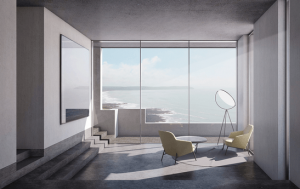The style of windows has a massive impact on architecture. They contribute a huge amount to the character of properties. At the same time they are vital for lighting and ventilation. Over the years there has been a big evolution in the glass you see in windows. We want to have a look at this today to see how far we have come and the options that are available now. Then if you want to design a property with the best architects in London, you can work with us.
Early uses
 Surprisingly the use of natural glass dates back to the prehistoric period. There is evidence of early humans using materials like obsidian to make tools, weapons, and even currency.
Surprisingly the use of natural glass dates back to the prehistoric period. There is evidence of early humans using materials like obsidian to make tools, weapons, and even currency.
Intentionally manufacturing glass dates back to 3,500 BC in Mesopotamia (Western Asia). However, it was a very complex process that took a lot of time. Craftsmen in Syria were the first to introduce glass blowing, making it easier, faster, and cheaper.
It was the Romans who would master glass manufacturing during the 1st century AD. They were able to expand it to produce higher quality materials in larger sizes. Soon they began to use the glass for windows because, although opaque, it would still allow light to pass in.
The next big development was the creation of stained glass. By adding different elements to the mix, it could be many different colours. People could then create elaborate patterns and designs with small pieces of coloured glass and soldering. These windows are still quite popular today. You can use them too with help from the most creative architects in London.
Crown glass
The next notable development was in 1674. Here manufacturers found a way to blow large globes of glass, cut it, and then flatten to create large panes. It is known as Crown glass and you can still find some examples of it all around the world.
After this there was a change to creating cylinders of glass rather than globes. They could then be cut and flattened to make even larger panes. Most windows from the early 19th century are this kind of glass.
Float glass
The advancement to allow the creation of the large clear panes of glass we know today is much newer, dating from the mid 1950s. It involves a bath of molten metal that you pour molten glass into. It cools to form and then requires cutting to shape.
The biggest advantage here is the panes can be really big, as much as several metres in size. It allows more possibilities in terms of large windows and full glazing systems. This is also a really efficient way to produce the glass and does not require as much cutting and milling.
Discuss your needs with the top architects in London
Deciding what windows to choose is really important when you look at architecture. Sadly manufacturers no longer produce Crown glass. There are some that still use the cylindrical method, so some products are available. There are also still some stained glass producers. However, most people will likely choose modern float glass.
What you need to think about here is the type of glazing you want. It is also crucial to look at frame options. If you want large, heavy windows with double or triple glazing, the frame will need to support it. There is even more to think about when you look at opening, such as mechanisms for bi-fold doors.
If you want to look at the options with some of the best architects London can offer, speak to us. Our team is creative and can use glazing effectively in many different ways, from traditional windows to glass walls, skylights to light wells.
